SEO
How to Value Your Website’s Worth (Better Than a Calculator)
If you’re considering selling your website, you need to know how much your website’s worth. While there are many website value calculators out there, most of them are inaccurate at best.
Website value calculators base their numbers purely on traffic and domain rating. To give you an idea of how inaccurate that is, a website that I’m in the process of selling for $500K was valued by one of these calculators at $14K.
Yikes!
Don’t worry—I’m going to teach you how to actually make an accurate analysis of how much your website could sell for.
If you have a website that doesn’t get any traffic or make any money, it’s probably not worth anything. But it may have value if you have a high-value domain name—but that’s an entirely different article.
If you do get traffic and/or have an income, that makes your website an online business. And there are a few different ways that websites (and online businesses) can be valued.
The value of your website comes down to three things:
- The income you generate (and where that income comes from)
- Your website’s traffic (and the quality of that traffic)
- Additional added value (e.g., backlink profile, social media audience, or email list)
Let’s quickly break down each of these and how they affect your potential sale price.
Income multiple
The most common (and highest-paying) method of valuing a website is a direct multiple of your business’s net profit. Net profit is how much your business takes home after expenses.
At the time of this post, a typical website sells for between 30 times and 45 times of the monthly net profit. So if you earn $10K per month net profit, your website can likely sell for $300K to $450K.
Where your site falls in that range can depend on a lot of other factors, such as:
- If you have multiple income streams – Websites that only have a single income stream (such as Google AdSense or Amazon Affiliates) sell for less than websites with multiple income streams (e.g., a mix of ads, affiliates, and physical or digital products).
- How reliant you are on paid advertising – If your income relies on a complex structure of paid advertising that isn’t easy for a non-expert to run, that can lower the sale price.
- If you have standard operating procedures (SOPs) – An SOP is a document that details exactly how to do tasks within your business, such as how you write, edit, and publish an article or how you build links. They make it easier for the new owner to take over, which could raise the sale price.
We will calculate your net profit (including subtracting add-backs, which I’ll explain) in the first step of the valuation. For now, let’s look at other ways to value your website and increase your monthly multiple.
Website traffic
The second-most-common way of valuing a website is by determining how much traffic the website gets. This is what most of those “online website worth” calculators use, and it’s kind of rubbish.
As I said in the intro, the website that I’m negotiating $500K for was valued at a meager $14K by those traffic value calculators.
Ahrefs estimates the monthly organic traffic value to be worth almost 10X that (at $130K) if we were to pay for it via search ads. So those calculators are poor judges of value.

If I were selling the site based solely on the traffic and it wasn’t making much of an income, this would probably be a more accurate price.
But you can still use traffic to help in your valuation. At the very least, the quality of your traffic (not the raw quantity) can help you achieve a higher monthly multiple on your sale.
If you get most of your traffic from search engines, your website will be worth more than a website that gets most of its traffic from social media or paid advertising.
This is because organic traffic takes longer and is harder to acquire than paid traffic. It requires creating high-quality content and building links, among other things.
Other valuation factors
Beyond net profit and traffic, there are a few other things that can push up that income multiple. These include:
- Your Domain Rating (DR) score and the quality of your backlinks.
- Your email list and social media following.
- Any other hard-to-duplicate factors.
Backlinks are extremely important for search engine optimization (SEO). And the higher the quality of links pointing to your site, the more it may be worth. The DR of your website is a score Ahrefs uses to gauge the strength of your backlink profile.
You can check your DR for free with our website authority checker.

However, simply looking at your DR is not enough—you have to dig deeper.
Where are your backlinks actually coming from? Are they from highly authoritative sites that are difficult to build links from, such as money.com or bankrate.com? Or did you use private blog networks (PBNs) and other low-quality link building tactics?
If it’s the former, that will raise your monthly multiple.
You can use the Referring domains report to see what backlinks you have and get a rough idea of the quality of those links. Just plug your site into Ahrefs’ Site Explorer and click “Referring domains” on the left.

Additionally, a strong email list or social media following with good engagement will be valuable to any potential buyer. Not just raw numbers; engagement is what really matters. It’s just too easy to pay a few bucks to artificially inflate your email or social media with low-quality bots.
Lastly, if your website has anything that’s unique and difficult to duplicate, that is often valuable to a buyer.
For example, I built an RV loan calculator tool for my website that cost thousands of dollars to have a developer build. This tool went on to rank for the keyword “RV loan calculator,” making it even more valuable.
Now that you know the factors that affect your website’s sale price, let’s actually come up with a number for you! Each of these steps will give you a value—but the more you follow, the more realistic your valuation will become.
Step 1. Create a financial spreadsheet
The very first thing you should do to calculate your website’s worth is create a spreadsheet, which includes your profit and loss, add-backs, and net profit.
Here’s an example of what that may look like:

You create a column for your revenue, then columns for each month. Do the same thing with your expenses. Revenue – Expenses = Net Profit.
Once you’ve listed your income and expenses, then you can create a section for add-backs (also called Discretionary Spending). These are expenses that the new owner won’t incur in the future or wouldn’t have incurred if they had owned the business.
For example, things like owner salaries, link building or content that created business growth, or web development.

With that done, calculate your net profit: Revenue – Expenses + Add-Backs = Net Profit.
Once you have the net profit for the last 12 months, simply add all of that together and divide by 12 to get your average monthly profit. Then take your average monthly profit and multiply it by 30 to 45 to get a range your website could sell for.
If that’s all you wanted—you’re done! But if you want to take it a step further and get a better idea of what you can realistically sell your website for, move on to step #2.
Recommendation
If your website doesn’t have any income and you purely want a valuation based on traffic, you can get a rough idea by using the traffic value metric in the Overview report from Ahrefs’ Site Explorer. It represents an estimated monthly cost of traffic from all keywords a site is ranking for if paid via PPC.

Step 2. Contact website valuation companies
There are online websites/business brokers who can help evaluate the value of your website and help you find a buyer, negotiate terms, and close the sale.
Places like Empire Flippers and Flippa are examples of such brokers.
They will evaluate your website’s worth for free. Just head to their site and fill out a form, and you’ll know your site’s worth within a week.
I recommend going through this process even if you don’t actually plan on using their brokerage services because it will give you a much better idea of what your website can realistically sell for in the current market. They do this for a living, so they’re pretty good at it.
When you sign up, you’ll get a Seller’s Dashboard with questions to answer and, eventually, offers for your site.

Once this part’s done, step #3 will help you get the best deal possible.
Step 3: Look for other interested parties to get the best deal
Working with brokers has a lot of perks: They can find the buyer for you, help negotiate the deal, and ensure a seamless transition into the new owner’s hands. They also provide legal help and make it so you don’t need to hire an attorney or worry about contracts and other complex things.
However, to provide these services, they take a hefty fee. In Empire Flipper’s case, it’s 8% of the sale price up to the first $700K as of this writing.
If you want to get a better deal and take more home when you sell, you should consider finding the buyer yourself and hiring an attorney to oversee the deal. In the end, if your site is big enough, this will end up saving you money.
That said, if you have a smaller site, it may not be worth the hassle to save a tiny amount.
But if your site is bigger, you can find buyers in a lot of ways. You can reach out to competitors directly to see if they’re interested in acquiring you, or you can look to other parties who can benefit from owning your site.
For example, if you own a site about automotive work, you can reach out to mechanics or companies that sell auto parts or bloggers who write about similar topics.
It will be a lot of extra work and manual outreach to find yourself a buyer. But if you want the best price, it’s the only way to get it.
Now you have an idea of what your website is worth and want to see that number get bigger. How do you do that? Obviously, you can do it by making more money. But beyond that, here are five ways to increase your sale price:
1. Diversify your income streams
Remember how I said websites with multiple income streams sell for more than those with a single income source? Well, if you only have one or two ways of making money, expanding that will help your multiple.
You can do that by:
- Adding display ads to your site through a display network like Ezoic or AdThrive.
- Branching out to other affiliates besides Amazon.
- Creating and selling your own physical or digital product.
If you’re able to, I highly recommend working out affiliate partnerships directly with the companies you love to promote.
Amazon’s affiliate program is great and easy to use, but it only pays a few percent. If you work out your own partnerships, you can get anywhere from 5% all the way up to 30% or more. It pays to build relationships and do things others are too lazy to work on.
2. Negotiate higher rates with affiliates
If you already have partnerships with different affiliates, an easy way to increase your income is by negotiating a higher rate.
It’s extremely common for affiliates to give out a higher commission if you just ask—so long as you have an existing relationship with them and you’re actually sending them sales.
Send them a quick email like this:
Hey [Name],
I’ve been working with you for X months/years now, and we’ve sent $X in sales to you. It’s been wonderful working with you, and we love promoting your products!
If you are able to bump our commission up to X%, that will give us more funds to promote your products to a wider audience and create more content around your brand.
Can we talk about getting this rate increase?
Thanks,
[Your Name]
Lastly, don’t be afraid to pick up the phone and call them. It can often be easier to negotiate over the phone or on a video call. You can use the power of human connection, as you’re not just an email address on a computer screen.
3. Reduce costs
If you reduce your business’s costs, you can sell it for more money. Duh, right?
Some easy ways to reduce costs:
- Canceling subscriptions you’re no longer using
- Paying for tools annually instead of monthly to save
- Review your finances and remove or reduce any unnecessary expenses
This one’s pretty self-explanatory, so I’ll leave it at that.
4. Diversify your traffic sources
Just like diversifying your income sources can increase your website’s value, having multiple traffic sources can offer the same result.
I already mentioned that organic traffic is more valuable than paid traffic. So you can start SEO efforts to get more organic traffic.
Besides that, you can also create and promote your brand on multiple social media channels. Start a TikTok account or a YouTube channel. Cross-post on Instagram and Facebook. Maybe even start a Facebook group and build a community.
These are all ways to increase your website’s traffic and, ultimately, how much you can sell it for.
5. Create standard operating procedures
SOPs not only make your business more valuable to buyers, but they also make it easier to run and hire people to do the tasks you’ve documented. This, in turn, makes it easier to scale up your business and make more money.
Essentially, an SOP is a document that outlines exactly how to do a specific task in your business step by step. They often include screenshots and even videos.
Here’s an example of one of my SOPs on finding and reaching out to influencers for content promotion:

It breaks down each step, explains the goal and process, and links to videos on how to specifically do each part of the process.
Here’s an excellent guide by Sweet Process that teaches you how to make SOPs.
So should you sell your website?
At this point, you should know how much your website is worth and how to increase that number.
If you’ve got this far, it probably means you have a profitable online business—something many people envy. Are you sure you want to sell it?
For me, I made the decision to sell one of my websites I’ve been working on for nearly a decade due to personal reasons, a need for capital, and (most importantly) burnout.
I was tired of working on it after all these years. It was an amazing business that mostly ran itself, but I was ready for a new chapter in my life.
If that’s you, maybe it’s time to sell.
SEO
Why Google Can’t Tell You About Every Ranking Drop

In a recent Twitter exchange, Google’s Search Liaison, Danny Sullivan, provided insight into how the search engine handles algorithmic spam actions and ranking drops.
The discussion was sparked by a website owner’s complaint about a significant traffic loss and the inability to request a manual review.
Sullivan clarified that a site could be affected by an algorithmic spam action or simply not ranking well due to other factors.
He emphasized that many sites experiencing ranking drops mistakenly attribute it to an algorithmic spam action when that may not be the case.
“I’ve looked at many sites where people have complained about losing rankings and decide they have a algorithmic spam action against them, but they don’t. “
Sullivan’s full statement will help you understand Google’s transparency challenges.
Additionally, he explains why the desire for manual review to override automated rankings may be misguided.
Two different things. A site could have an algorithmic spam action. A site could be not ranking well because other systems that *are not about spam* just don’t see it as helpful.
I’ve looked at many sites where people have complained about losing rankings and decide they have a…
— Google SearchLiaison (@searchliaison) May 13, 2024
Challenges In Transparency & Manual Intervention
Sullivan acknowledged the idea of providing more transparency in Search Console, potentially notifying site owners of algorithmic actions similar to manual actions.
However, he highlighted two key challenges:
- Revealing algorithmic spam indicators could allow bad actors to game the system.
- Algorithmic actions are not site-specific and cannot be manually lifted.
Sullivan expressed sympathy for the frustration of not knowing the cause of a traffic drop and the inability to communicate with someone about it.
However, he cautioned against the desire for a manual intervention to override the automated systems’ rankings.
Sullivan states:
“…you don’t really want to think “Oh, I just wish I had a manual action, that would be so much easier.” You really don’t want your individual site coming the attention of our spam analysts. First, it’s not like manual actions are somehow instantly processed. Second, it’s just something we know about a site going forward, especially if it says it has change but hasn’t really.”
Determining Content Helpfulness & Reliability
Moving beyond spam, Sullivan discussed various systems that assess the helpfulness, usefulness, and reliability of individual content and sites.
He acknowledged that these systems are imperfect and some high-quality sites may not be recognized as well as they should be.
“Some of them ranking really well. But they’ve moved down a bit in small positions enough that the traffic drop is notable. They assume they have fundamental issues but don’t, really — which is why we added a whole section about this to our debugging traffic drops page.”
Sullivan revealed ongoing discussions about providing more indicators in Search Console to help creators understand their content’s performance.
“Another thing I’ve been discussing, and I’m not alone in this, is could we do more in Search Console to show some of these indicators. This is all challenging similar to all the stuff I said about spam, about how not wanting to let the systems get gamed, and also how there’s then no button we would push that’s like “actually more useful than our automated systems think — rank it better!” But maybe there’s a way we can find to share more, in a way that helps everyone and coupled with better guidance, would help creators.”
Advocacy For Small Publishers & Positive Progress
In response to a suggestion from Brandon Saltalamacchia, founder of RetroDodo, about manually reviewing “good” sites and providing guidance, Sullivan shared his thoughts on potential solutions.
He mentioned exploring ideas such as self-declaration through structured data for small publishers and learning from that information to make positive changes.
“I have some thoughts I’ve been exploring and proposing on what we might do with small publishers and self-declaring with structured data and how we might learn from that and use that in various ways. Which is getting way ahead of myself and the usual no promises but yes, I think and hope for ways to move ahead more positively.”
Sullivan said he can’t make promises or implement changes overnight, but he expressed hope for finding ways to move forward positively.
Featured Image: Tero Vesalainen/Shutterstock
SEO
56 Google Search Statistics to Bookmark for 2024
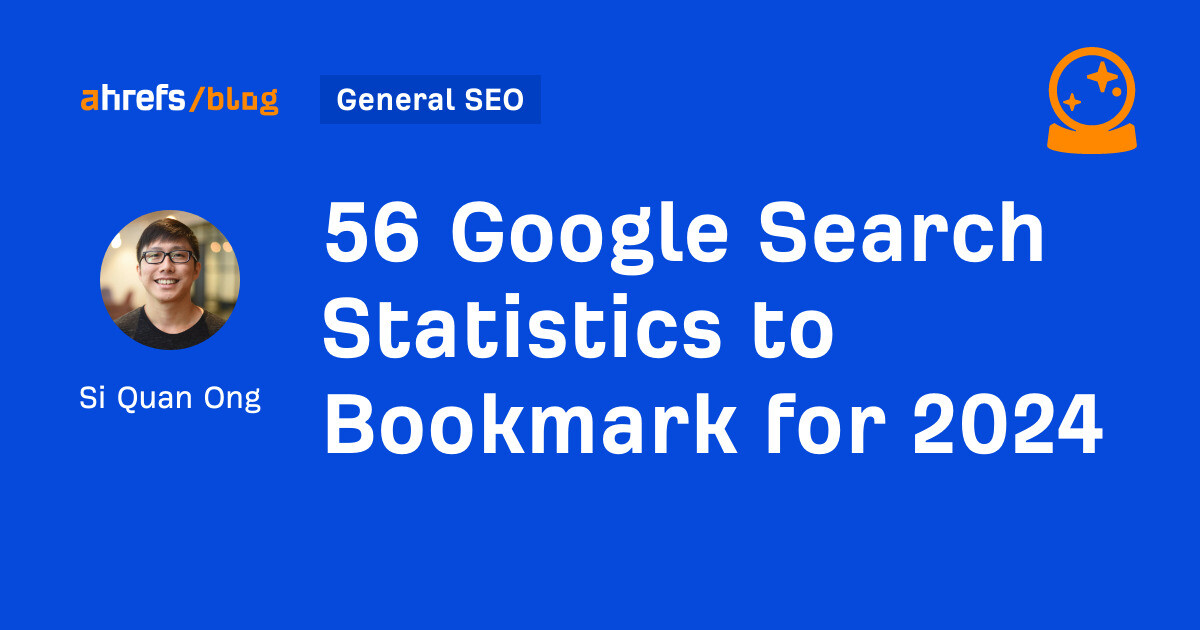
If you’re curious about the state of Google search in 2024, look no further.
Each year we pick, vet, and categorize a list of up-to-date statistics to give you insights from trusted sources on Google search trends.
- Google has a web index of “about 400 billion documents”. (The Capitol Forum)
- Google’s search index is over 100 million gigabytes in size. (Google)
- There are an estimated 3.5 billion searches on Google each day. (Internet Live Stats)
- 61.5% of desktop searches and 34.4% of mobile searches result in no clicks. (SparkToro)
- 15% of all Google searches have never been searched before. (Google)
- 94.74% of keywords get 10 monthly searches or fewer. (Ahrefs)
- The most searched keyword in the US and globally is “YouTube,” and youtube.com gets the most traffic from Google. (Ahrefs)
- 96.55% of all pages get zero search traffic from Google. (Ahrefs)
- 50-65% of all number-one spots are dominated by featured snippets. (Authority Hacker)
- Reddit is the most popular domain for product review queries. (Detailed)
- Google is the most used search engine in the world, with a mobile market share of 95.32% and a desktop market share of 81.95%. (Statista)
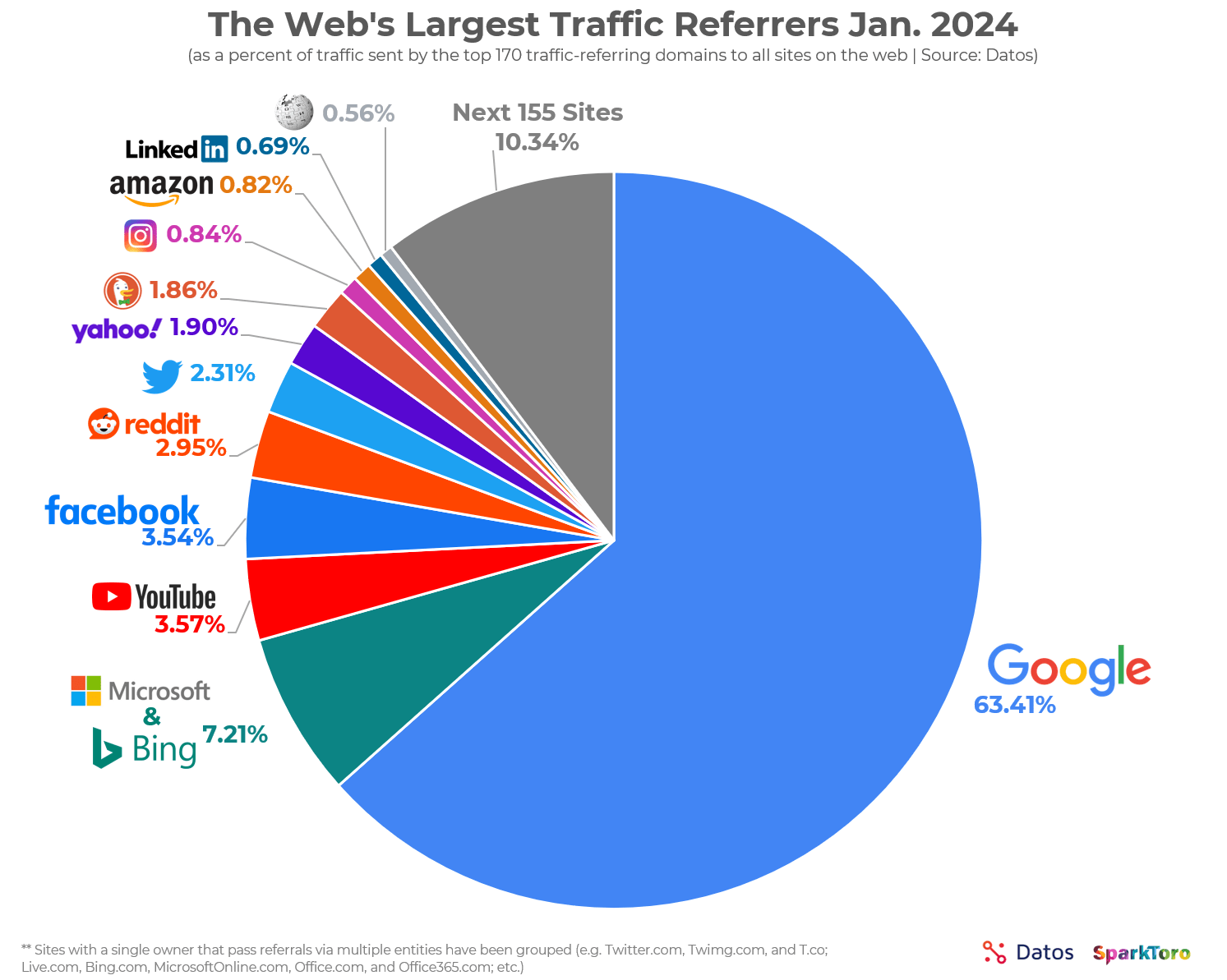

- Google.com generated 84.2 billion visits a month in 2023. (Statista)
- Google generated $307.4 billion in revenue in 2023. (Alphabet Investor Relations)
- 63.41% of all US web traffic referrals come from Google. (SparkToro)
- 92.96% of global traffic comes from Google Search, Google Images, and Google Maps. (SparkToro)
- Only 49% of Gen Z women use Google as their search engine. The rest use TikTok. (Search Engine Land)
- 58.67% of all website traffic worldwide comes from mobile phones. (Statista)
- 57% of local search queries are submitted using a mobile device or tablet. (ReviewTrackers)
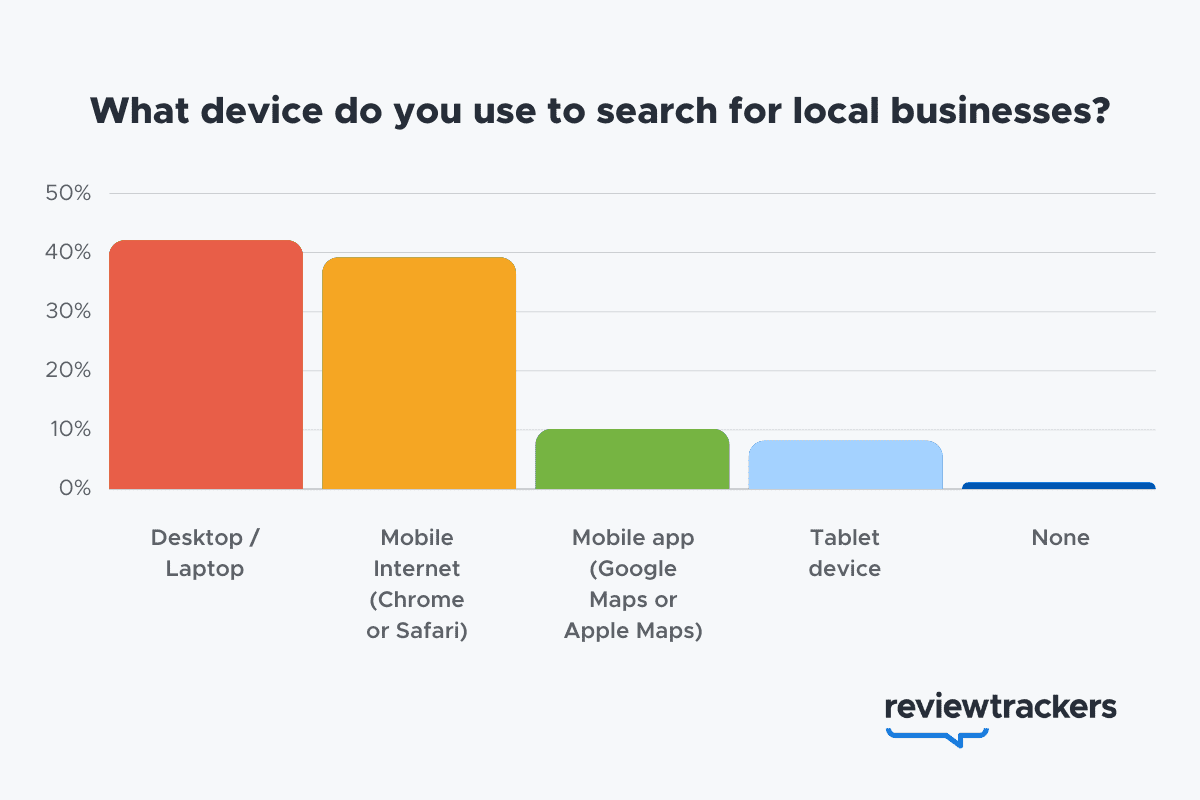

- 51% of smartphone users have discovered a new company or product when conducting a search on their smartphones. (Think With Google)
- 54% of smartphone users search for business hours, and 53% search for directions to local stores. (Think With Google)
- 18% of local searches on smartphones lead to a purchase within a day vs. 7% of non-local searches. (Think With Google)
- 56% of in-store shoppers used their smartphones to shop or research items while they were in-store. (Think With Google)
- 60% of smartphone users have contacted a business directly using the search results (e.g., “click to call” option). (Think With Google)
- 63.6% of consumers say they are likely to check reviews on Google before visiting a business location. (ReviewTrackers)
- 88% of consumers would use a business that replies to all of its reviews. (BrightLocal)
- Customers are 2.7 times more likely to consider a business reputable if they find a complete Business Profile on Google Search and Maps. (Google)
- Customers are 70% more likely to visit and 50% more likely to consider purchasing from businesses with a complete Business Profile. (Google)
- 76% of people who search on their smartphones for something nearby visit a business within a day. (Think With Google)
- 28% of searches for something nearby result in a purchase. (Think With Google)
- Mobile searches for “store open near me” (such as, “grocery store open near me” have grown by over 250% in the last two years. (Think With Google)
- People use Google Lens for 12 billion visual searches a month. (Google)
- 50% of online shoppers say images helped them decide what to buy. (Think With Google)
- There are an estimated 136 billion indexed images on Google Image Search. (Photutorial)
- 15.8% of Google SERPs show images. (Moz)
- People click on 3D images almost 50% more than static ones. (Google)
- More than 800 million people use Google Discover monthly to stay updated on their interests. (Google)
- 46% of Google Discover URLs are news sites, 44% e-commerce, 7% entertainment, and 2% travel. (Search Engine Journal)
- Even though news sites accounted for under 50% of Google Discover URLs, they received 99% of Discover clicks. (Search Engine Journal)
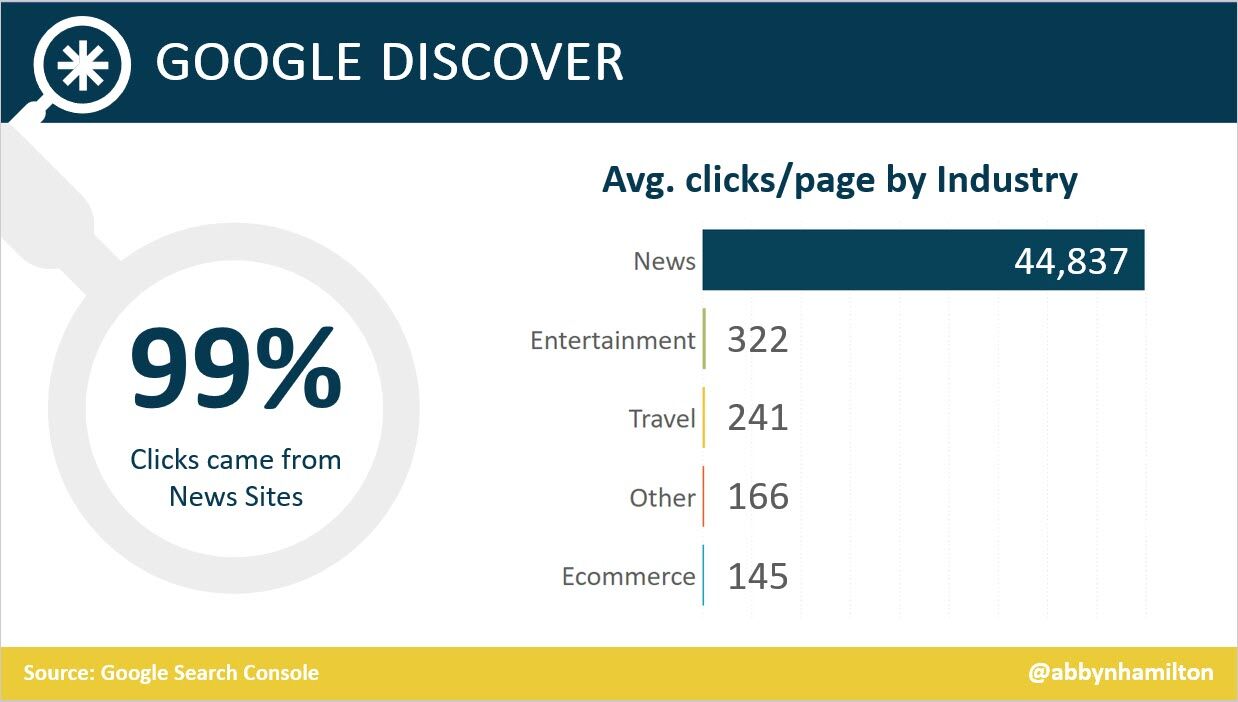

- Most Google Discover URLs only receive traffic for three to four days, with most of that traffic occurring one to two days after publishing. (Search Engine Journal)
- The clickthrough rate (CTR) for Google Discover is 11%. (Search Engine Journal)
- 91.45% of search volumes in Google Ads Keyword Planner are overestimates. (Ahrefs)
- For every $1 a business spends on Google Ads, they receive $8 in profit through Google Search and Ads. (Google)
- Google removed 5.5 billion ads, suspended 12.7 million advertiser accounts, restricted over 6.9 billion ads, and restricted ads from showing up on 2.1 billion publisher pages in 2023. (Google)
- The average shopping click-through rate (CTR) across all industries is 0.86% for Google Ads. (Wordstream)
- The average shopping cost per click (CPC) across all industries is $0.66 for Google Ads. (Wordstream)
- The average shopping conversion rate (CVR) across all industries is 1.91% for Google Ads. (Wordstream)
- 58% of consumers ages 25-34 use voice search daily. (UpCity)
- 16% of people use voice search for local “near me” searches. (UpCity)
- 67% of consumers say they’re very likely to use voice search when seeking information. (UpCity)
- Active users of the Google Assistant grew 4X over the past year, as of 2019. (Think With Google)
- Google Assistant hit 1 billion app installs. (Android Police)
- AI-generated answers from SGE were available for 91% of entertainment queries but only 17% of healthcare queries. (Statista)
- The AI-generated answers in Google’s Search Generative Experience (SGE) do not match any links from the top 10 Google organic search results 93.8% of the time. (Search Engine Journal)
- Google displays a Search Generative element for 86.8% of all search queries. (Authoritas)
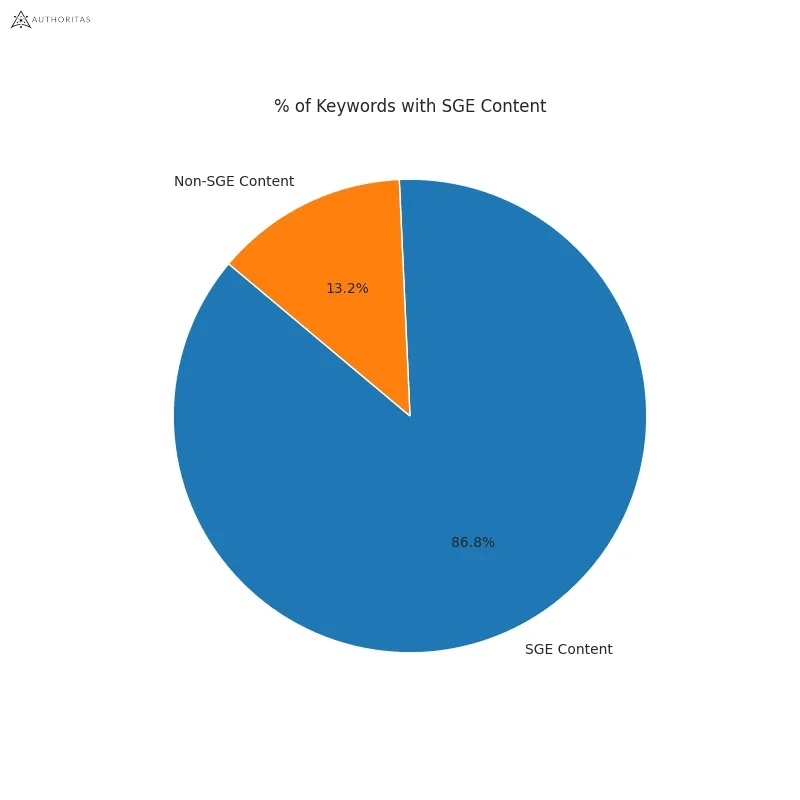

- 62% of generative links came from sources outside the top 10 ranking organic domains. Only 20.1% of generative URLs directly match an organic URL ranking on page one. (Authoritas)
- 70% of SEOs said that they were worried about the impact of SGE on organic search (Aira)
Learn more
Check out more resources on how Google works:
SEO
How To Use ChatGPT For Keyword Research

Anyone not using ChatGPT for keyword research is missing a trick.
You can save time and understand an entire topic in seconds instead of hours.
In this article, I outline my most effective ChatGPT prompts for keyword research and teach you how I put them together so that you, too, can take, edit, and enhance them even further.
But before we jump into the prompts, I want to emphasize that you shouldn’t replace keyword research tools or disregard traditional keyword research methods.
ChatGPT can make mistakes. It can even create new keywords if you give it the right prompt. For example, I asked it to provide me with a unique keyword for the topic “SEO” that had never been searched before.
“Interstellar Internet SEO: Optimizing content for the theoretical concept of an interstellar internet, considering the challenges of space-time and interplanetary communication delays.”
Although I want to jump into my LinkedIn profile and update my title to “Interstellar Internet SEO Consultant,” unfortunately, no one has searched that (and they probably never will)!
You must not blindly rely on the data you get back from ChatGPT.
What you can rely on ChatGPT for is the topic ideation stage of keyword research and inspiration.
ChatGPT is a large language model trained with massive amounts of data to accurately predict what word will come next in a sentence. However, it does not know how to do keyword research yet.
Instead, think of ChatGPT as having an expert on any topic armed with the information if you ask it the right question.
In this guide, that is exactly what I aim to teach you how to do – the most essential prompts you need to know when performing topical keyword research.
Best ChatGPT Keyword Research Prompts
The following ChatGPT keyword research prompts can be used on any niche, even a topic to which you are brand new.
For this demonstration, let’s use the topic of “SEO” to demonstrate these prompts.
Generating Keyword Ideas Based On A Topic
What Are The {X} Most Popular Sub-topics Related To {Topic}?
The first prompt is to give you an idea of the niche.
As shown above, ChatGPT did a great job understanding and breaking down SEO into three pillars: on-page, off-page & technical.
The key to the following prompt is to take one of the topics ChatGPT has given and query the sub-topics.
What Are The {X} Most Popular Sub-topics Related To {Sub-topic}?
For this example, let’s query, “What are the most popular sub-topics related to keyword research?”
Having done keyword research for over 10 years, I would expect it to output information related to keyword research metrics, the types of keywords, and intent.
Let’s see.
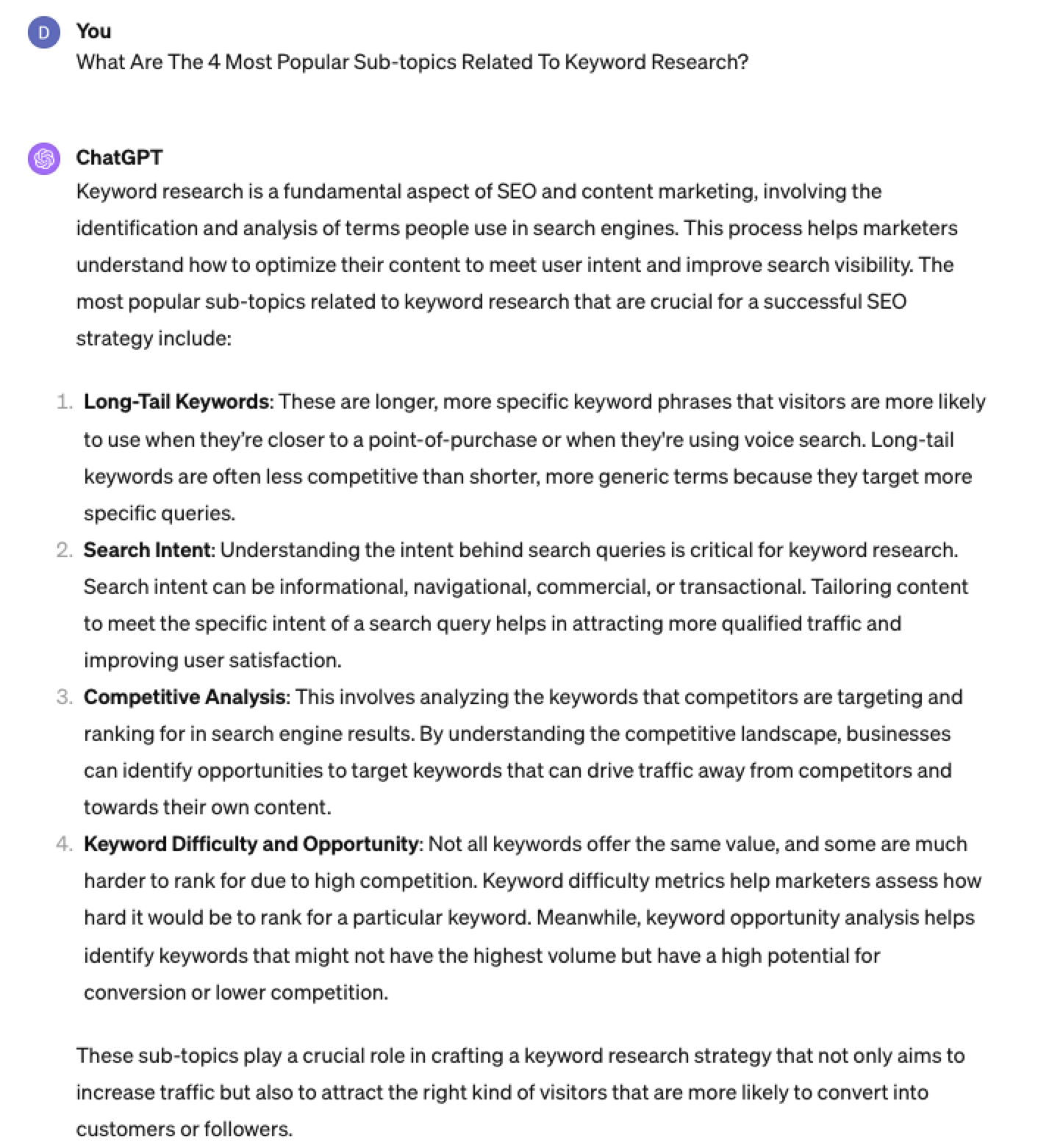 Screenshot from ChatGPT 4, April 2024
Screenshot from ChatGPT 4, April 2024Again, right on the money.
To get the keywords you want without having ChatGPT describe each answer, use the prompt “list without description.”
Here is an example of that.
List Without Description The Top {X} Most Popular Keywords For The Topic Of {X}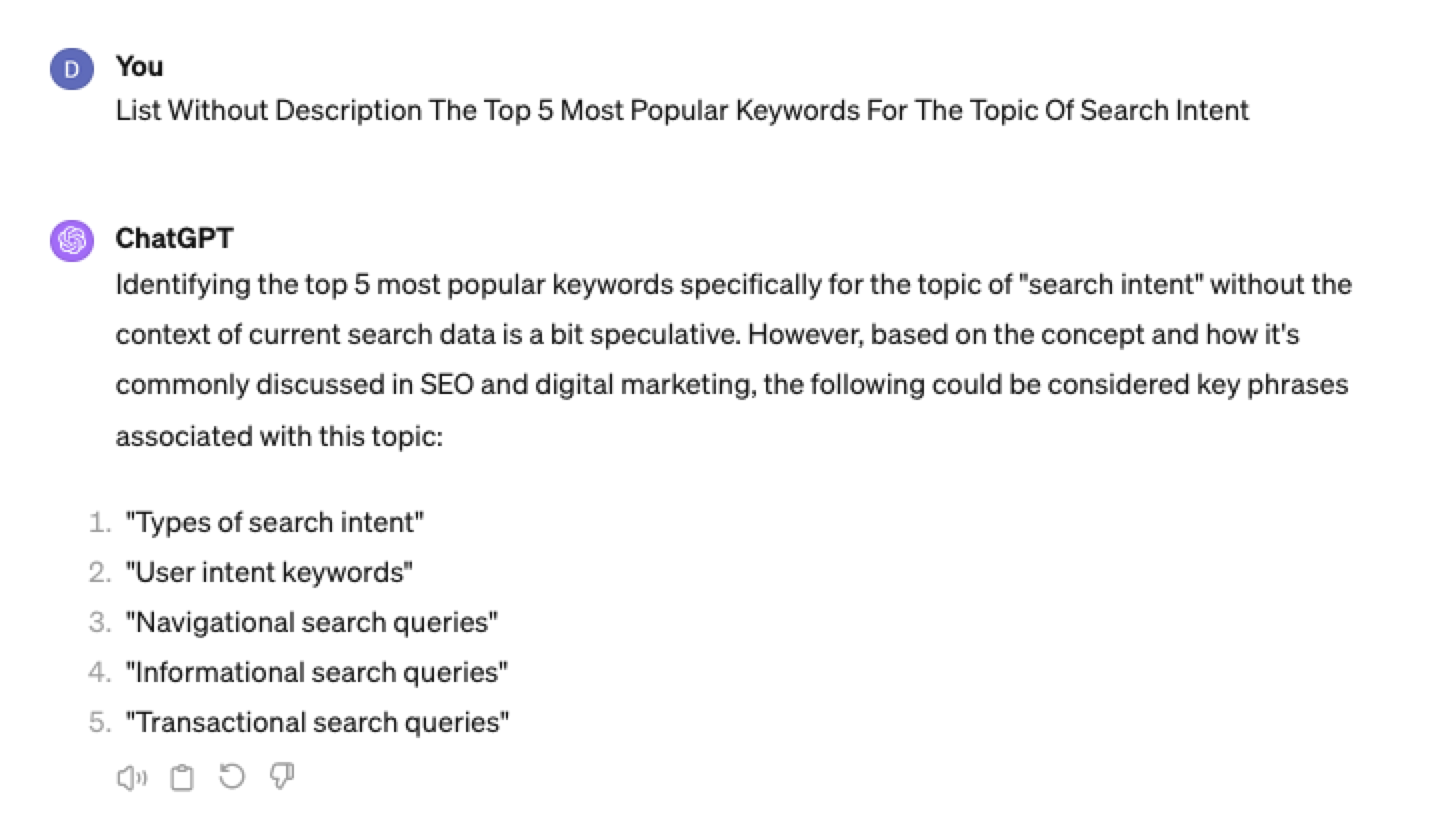
You can even branch these keywords out further into their long-tail.
Example prompt:
List Without Description The Top {X} Most Popular Long-tail Keywords For The Topic “{X}”
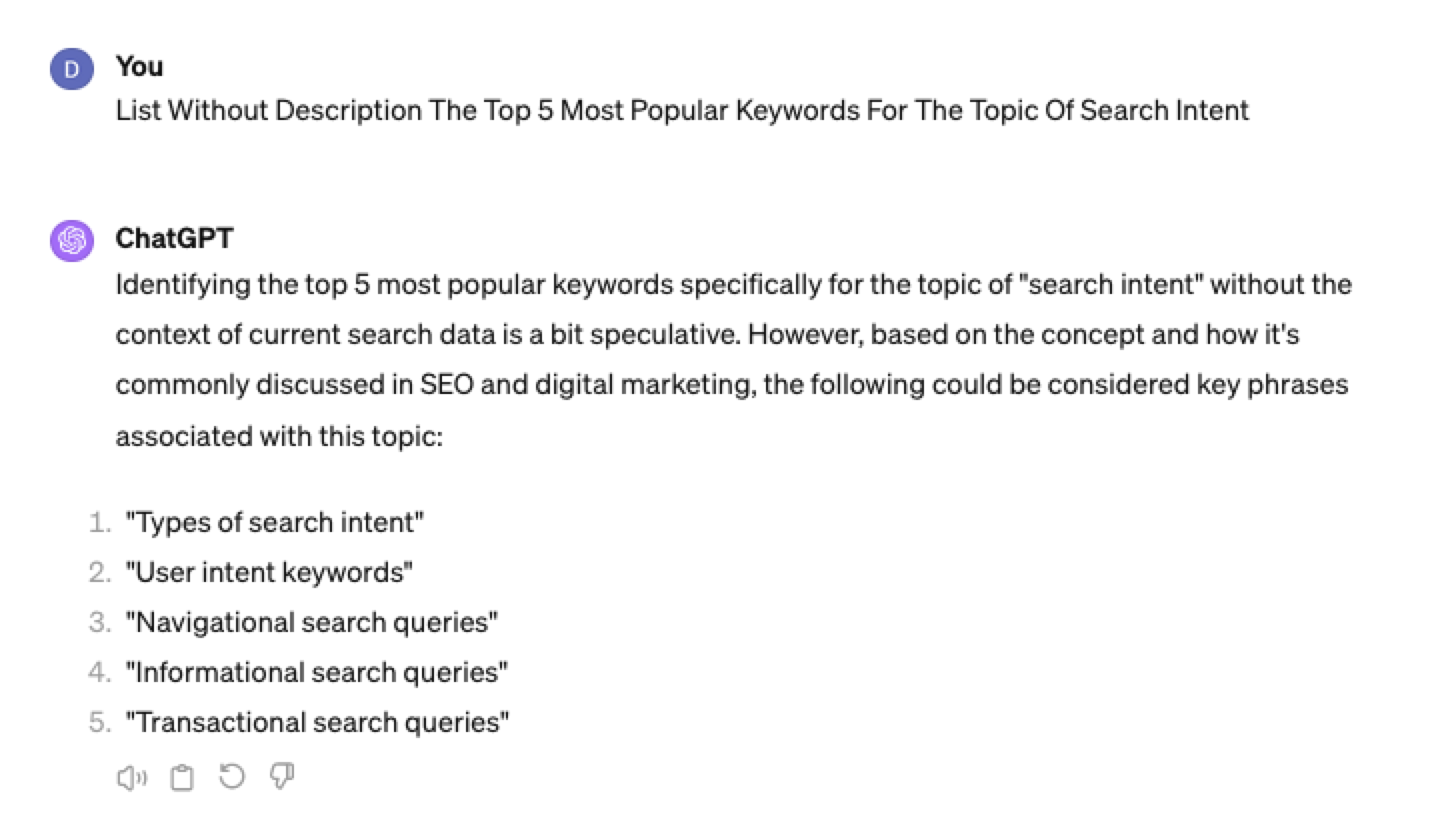 Screenshot ChatGPT 4,April 2024
Screenshot ChatGPT 4,April 2024List Without Description The Top Semantically Related Keywords And Entities For The Topic {X}
You can even ask ChatGPT what any topic’s semantically related keywords and entities are!
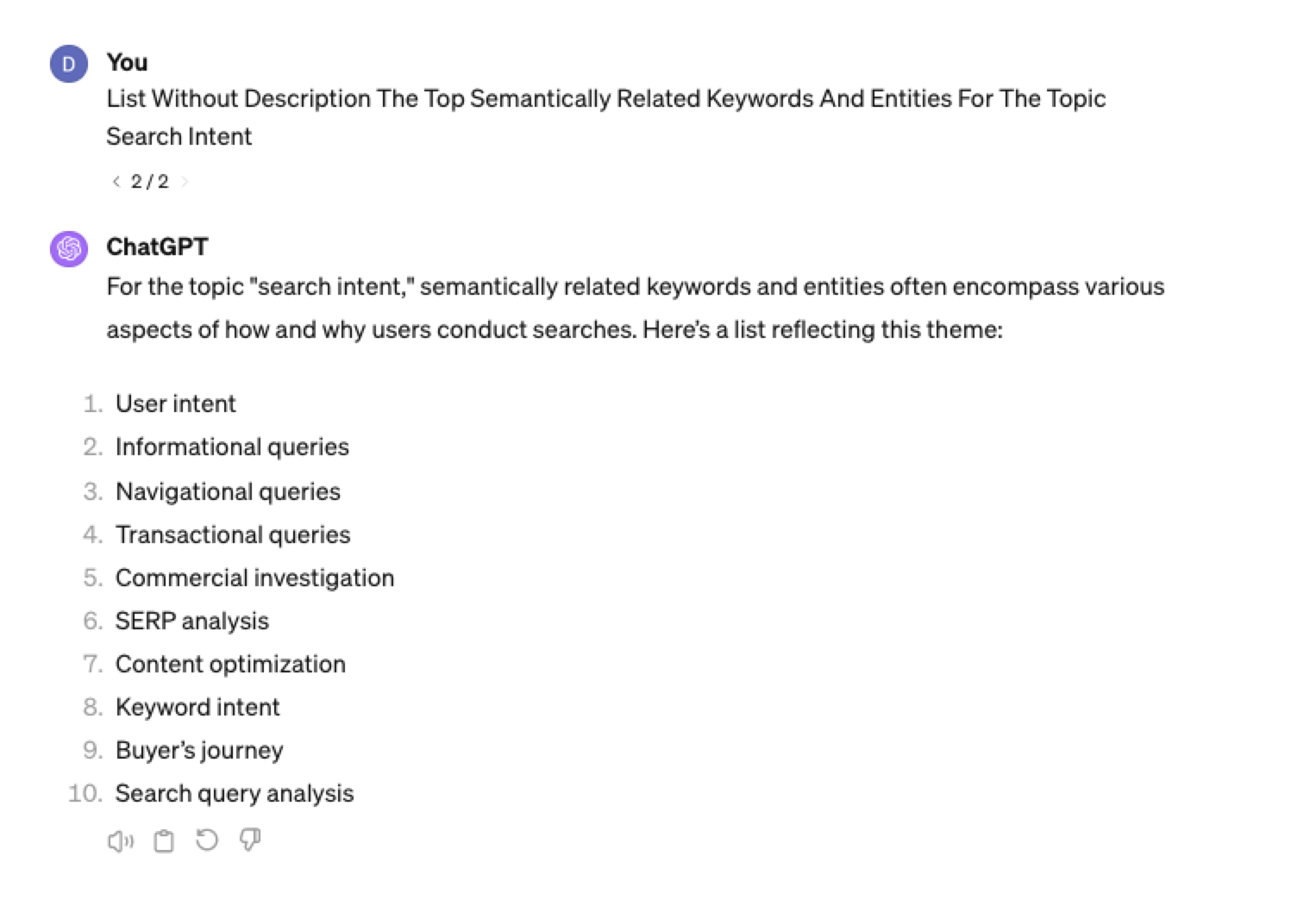 Screenshot ChatGPT 4, April 2024
Screenshot ChatGPT 4, April 2024Tip: The Onion Method Of Prompting ChatGPT
When you are happy with a series of prompts, add them all to one prompt. For example, so far in this article, we have asked ChatGPT the following:
- What are the four most popular sub-topics related to SEO?
- What are the four most popular sub-topics related to keyword research
- List without description the top five most popular keywords for “keyword intent”?
- List without description the top five most popular long-tail keywords for the topic “keyword intent types”?
- List without description the top semantically related keywords and entities for the topic “types of keyword intent in SEO.”
Combine all five into one prompt by telling ChatGPT to perform a series of steps. Example:
“Perform the following steps in a consecutive order Step 1, Step 2, Step 3, Step 4, and Step 5”
Example:
“Perform the following steps in a consecutive order Step 1, Step 2, Step 3, Step 4 and Step 5. Step 1 – Generate an answer for the 3 most popular sub-topics related to {Topic}?. Step 2 – Generate 3 of the most popular sub-topics related to each answer. Step 3 – Take those answers and list without description their top 3 most popular keywords. Step 4 – For the answers given of their most popular keywords, provide 3 long-tail keywords. Step 5 – for each long-tail keyword offered in the response, a list without descriptions 3 of their top semantically related keywords and entities.”
Generating Keyword Ideas Based On A Question
Taking the steps approach from above, we can get ChatGPT to help streamline getting keyword ideas based on a question. For example, let’s ask, “What is SEO?”
“Perform the following steps in a consecutive order Step 1, Step 2, Step 3, and Step 4. Step 1 Generate 10 questions about “{Question}”?. Step 2 – Generate 5 more questions about “{Question}” that do not repeat the above. Step 3 – Generate 5 more questions about “{Question}” that do not repeat the above. Step 4 – Based on the above Steps 1,2,3 suggest a final list of questions avoiding duplicates or semantically similar questions.”
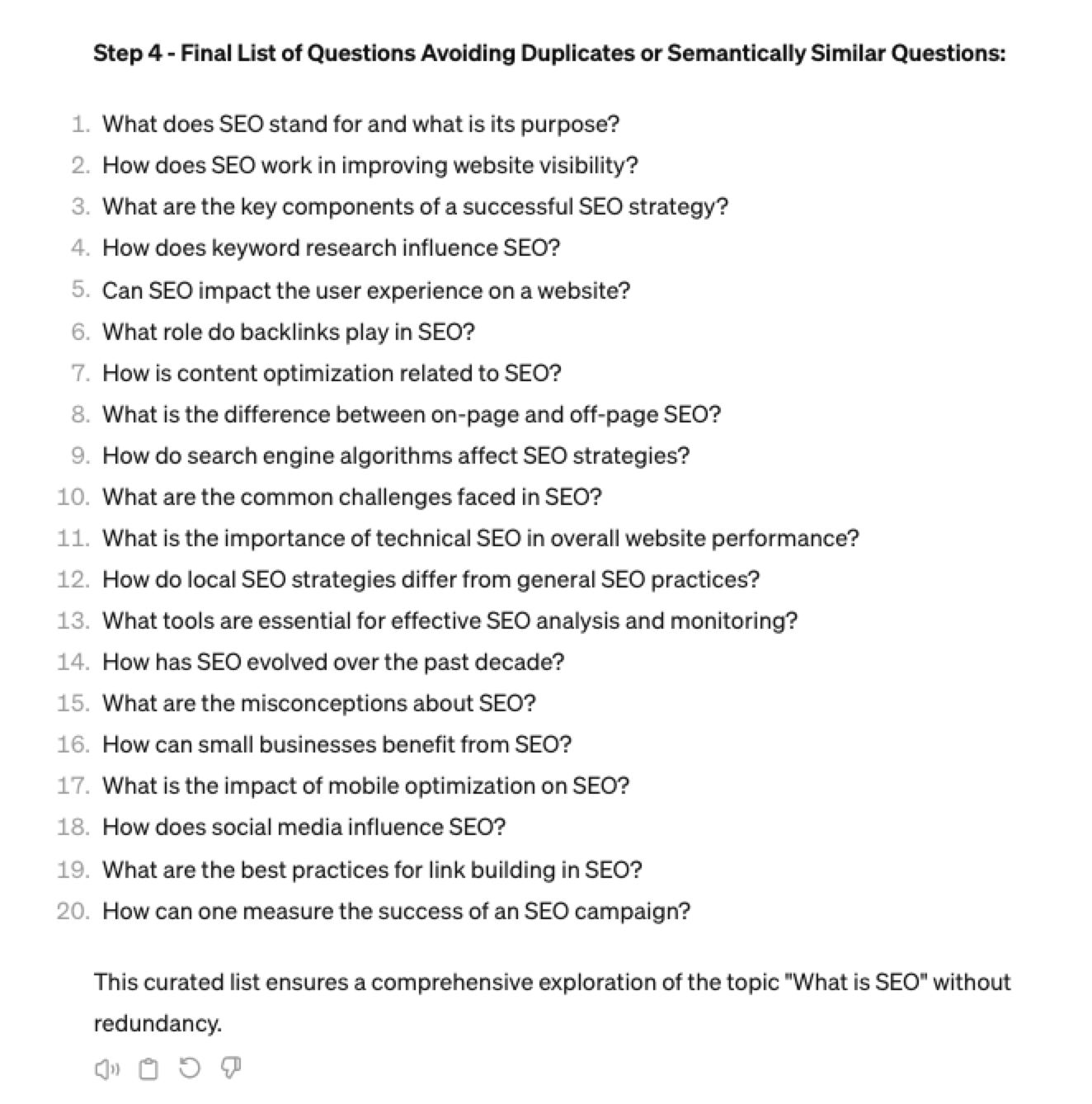 Screenshot ChatGPT 4, April 2024
Screenshot ChatGPT 4, April 2024Generating Keyword Ideas Using ChatGPT Based On The Alphabet Soup Method
One of my favorite methods, manually, without even using a keyword research tool, is to generate keyword research ideas from Google autocomplete, going from A to Z.
-
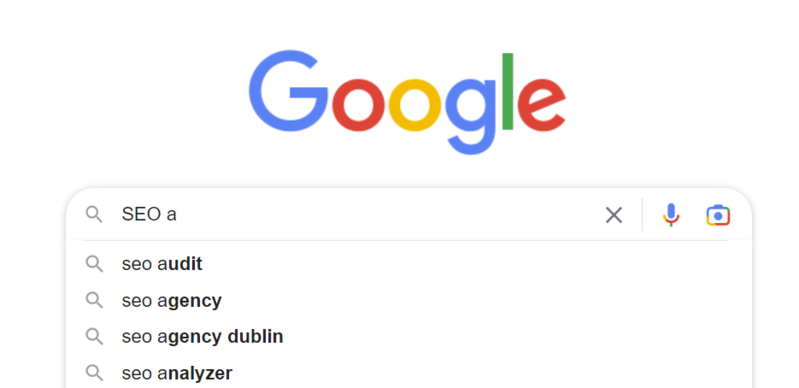 Screenshot from Google autocomplete, April 2024
Screenshot from Google autocomplete, April 2024
You can also do this using ChatGPT.
Example prompt:
“give me popular keywords that includes the keyword “SEO”, and the next letter of the word starts with a”
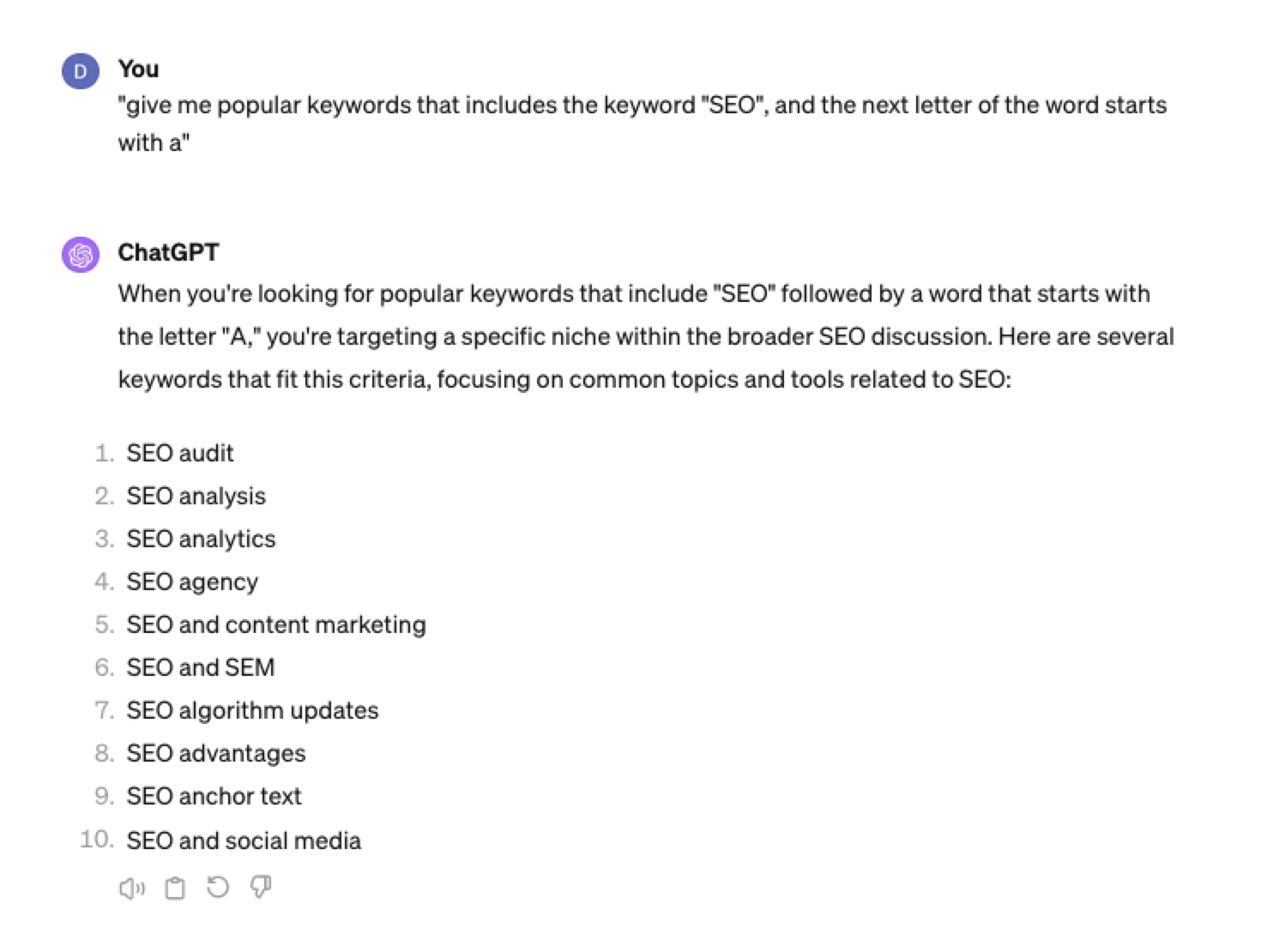 Screenshot from ChatGPT 4, April 2024
Screenshot from ChatGPT 4, April 2024Tip: Using the onion prompting method above, we can combine all this in one prompt.
“Give me five popular keywords that include “SEO” in the word, and the following letter starts with a. Once the answer has been done, move on to giving five more popular keywords that include “SEO” for each letter of the alphabet b to z.”
Generating Keyword Ideas Based On User Personas
When it comes to keyword research, understanding user personas is essential for understanding your target audience and keeping your keyword research focused and targeted. ChatGPT may help you get an initial understanding of customer personas.
Example prompt:
“For the topic of “{Topic}” list 10 keywords each for the different types of user personas”
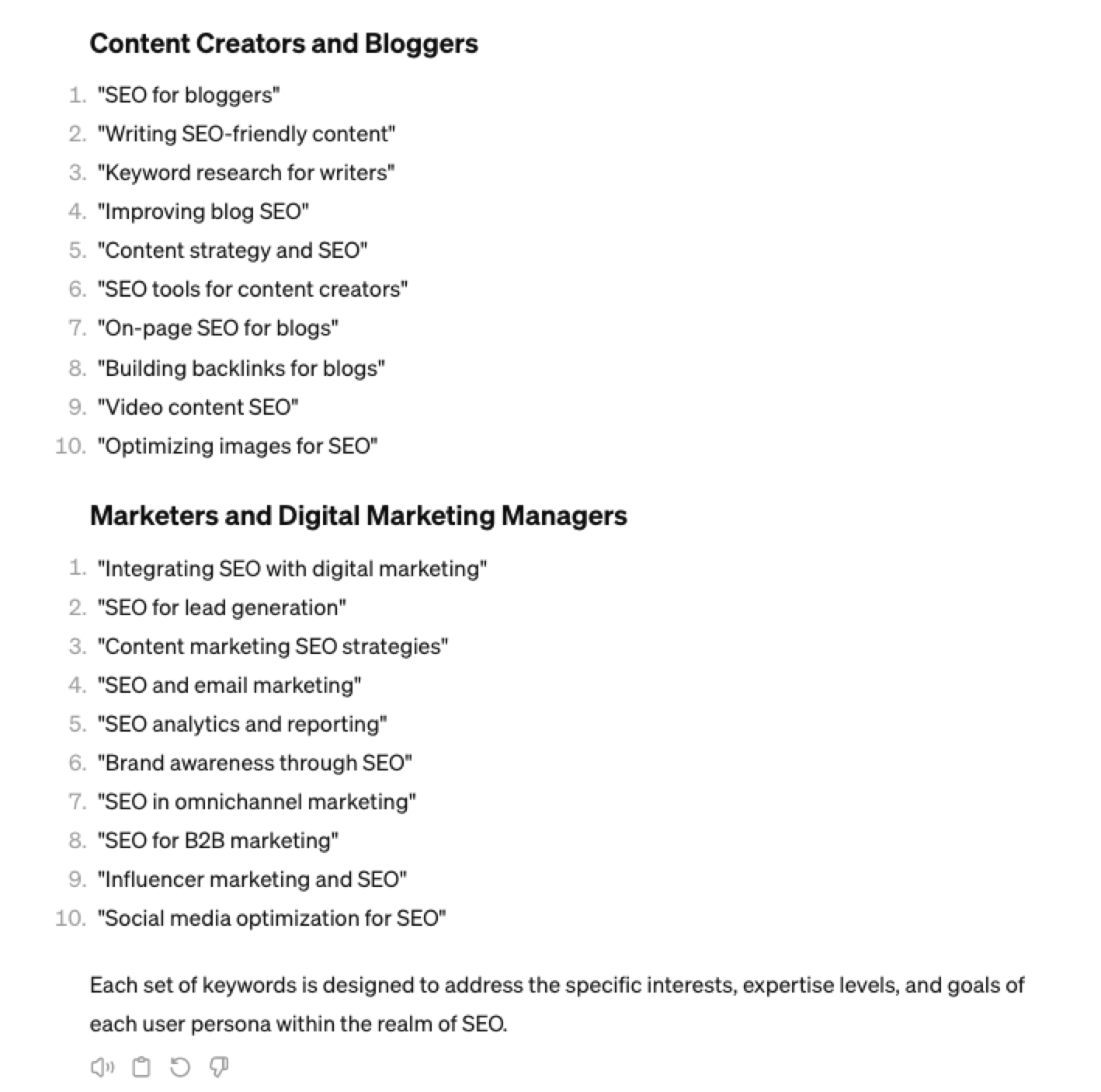 Screenshot from ChatGPT 4, April 2024
Screenshot from ChatGPT 4, April 2024You could even go a step further and ask for questions based on those topics that those specific user personas may be searching for:
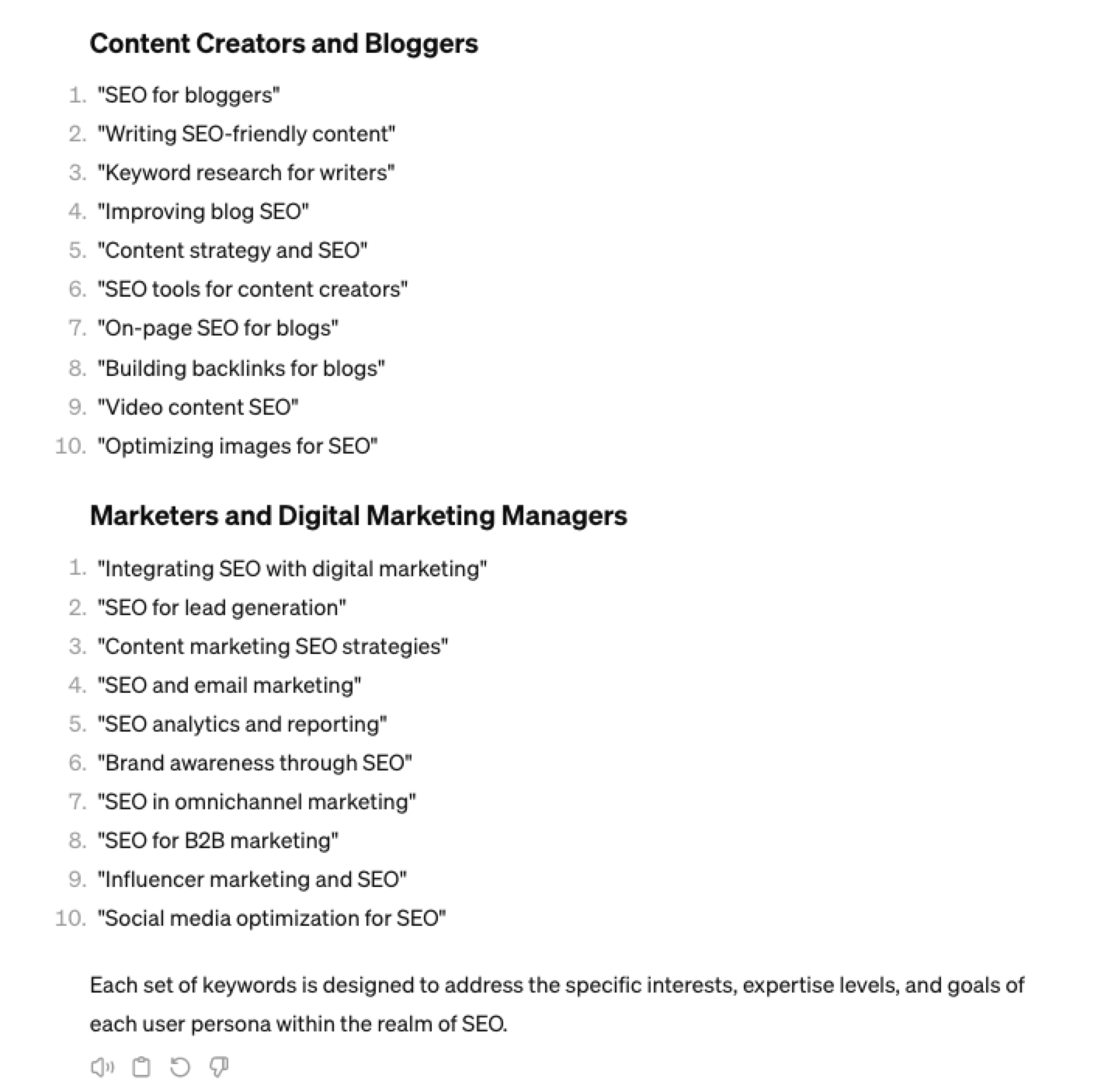 Screenshot ChatGPT 4, April 2024
Screenshot ChatGPT 4, April 2024As well as get the keywords to target based on those questions:
“For each question listed above for each persona, list the keywords, as well as the long-tail keywords to target, and put them in a table”
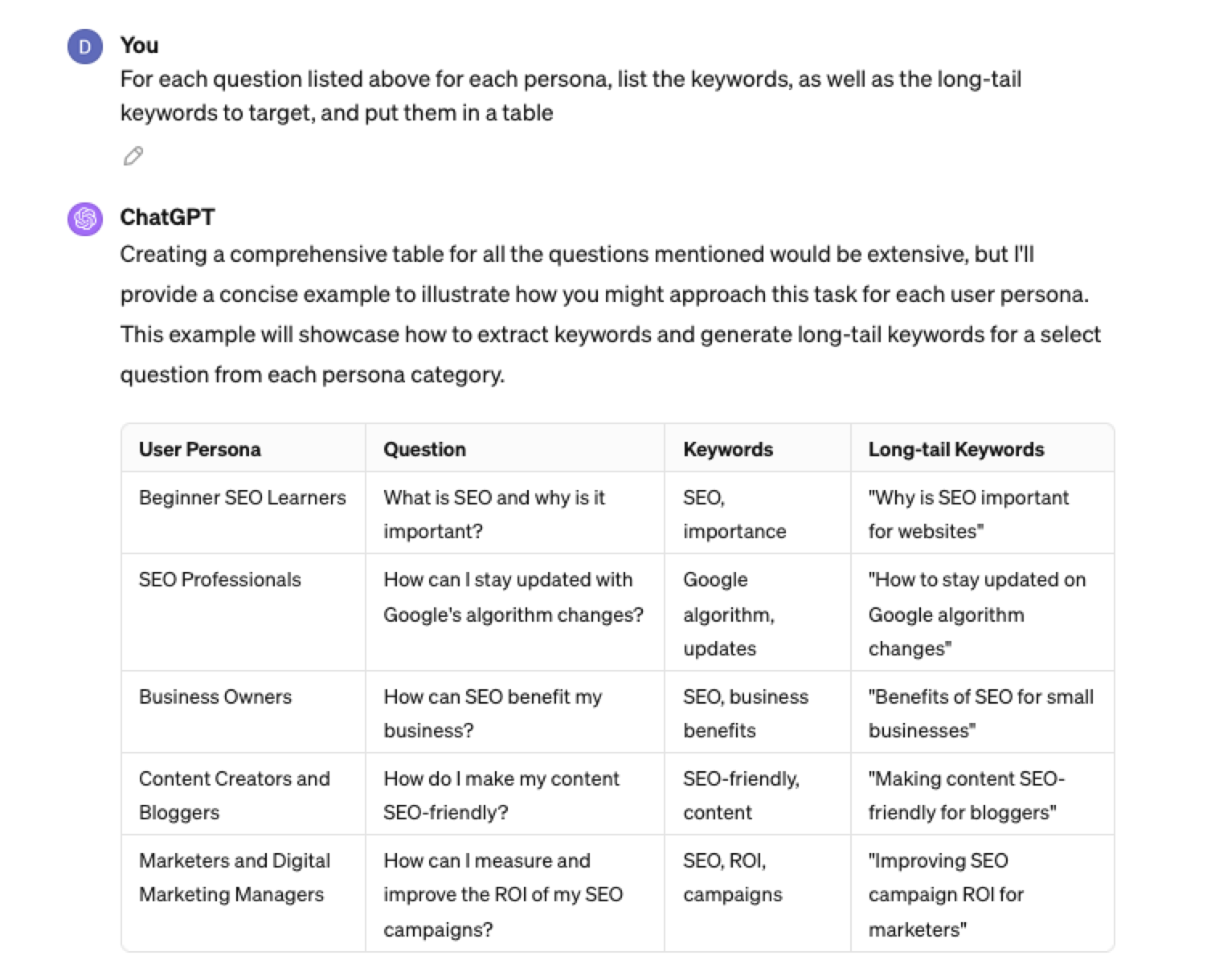 Screenshot from ChatGPT 4, April 2024
Screenshot from ChatGPT 4, April 2024Generating Keyword Ideas Using ChatGPT Based On Searcher Intent And User Personas
Understanding the keywords your target persona may be searching is the first step to effective keyword research. The next step is to understand the search intent behind those keywords and which content format may work best.
For example, a business owner who is new to SEO or has just heard about it may be searching for “what is SEO.”
However, if they are further down the funnel and in the navigational stage, they may search for “top SEO firms.”
You can query ChatGPT to inspire you here based on any topic and your target user persona.
SEO Example:
“For the topic of “{Topic}” list 10 keywords each for the different types of searcher intent that a {Target Persona} would be searching for”
ChatGPT For Keyword Research Admin
Here is how you can best use ChatGPT for keyword research admin tasks.
Using ChatGPT As A Keyword Categorization Tool
One of the use cases for using ChatGPT is for keyword categorization.
In the past, I would have had to devise spreadsheet formulas to categorize keywords or even spend hours filtering and manually categorizing keywords.
ChatGPT can be a great companion for running a short version of this for you.
Let’s say you have done keyword research in a keyword research tool, have a list of keywords, and want to categorize them.
You could use the following prompt:
“Filter the below list of keywords into categories, target persona, searcher intent, search volume and add information to a six-column table: List of keywords – [LIST OF KEYWORDS], Keyword Search Volume [SEARCH VOLUMES] and Keyword Difficulties [KEYWORD DIFFICUTIES].”
-
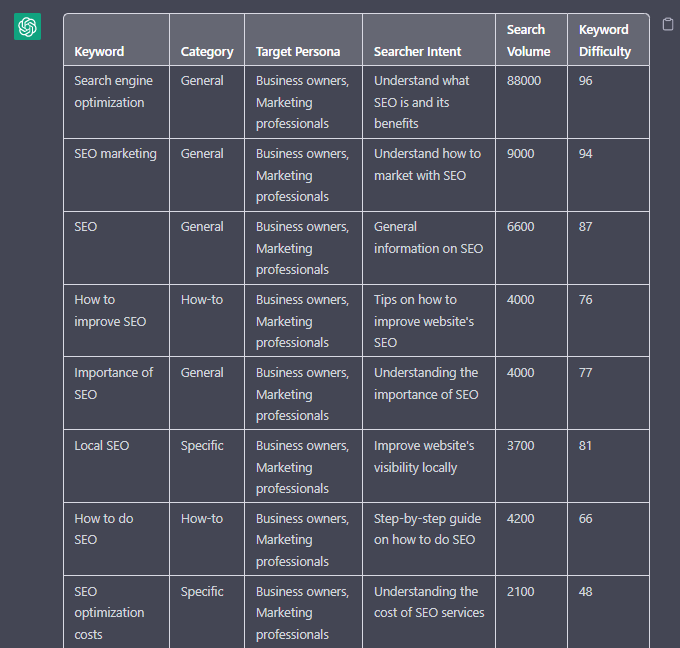 Screenshot from ChatGPT, April 2024
Screenshot from ChatGPT, April 2024
Tip: Add keyword metrics from the keyword research tools, as using the search volumes that a ChatGPT prompt may give you will be wildly inaccurate at best.
Using ChatGPT For Keyword Clustering
Another of ChatGPT’s use cases for keyword research is to help you cluster. Many keywords have the same intent, and by grouping related keywords, you may find that one piece of content can often target multiple keywords at once.
However, be careful not to rely only on LLM data for clustering. What ChatGPT may cluster as a similar keyword, the SERP or the user may not agree with. But it is a good starting point.
The big downside of using ChatGPT for keyword clustering is actually the amount of keyword data you can cluster based on the memory limits.
So, you may find a keyword clustering tool or script that is better for large keyword clustering tasks. But for small amounts of keywords, ChatGPT is actually quite good.
A great use small keyword clustering use case using ChatGPT is for grouping People Also Ask (PAA) questions.
Use the following prompt to group keywords based on their semantic relationships. For example:
“Organize the following keywords into groups based on their semantic relationships, and give a short name to each group: [LIST OF PAA], create a two-column table where each keyword sits on its own row.
-
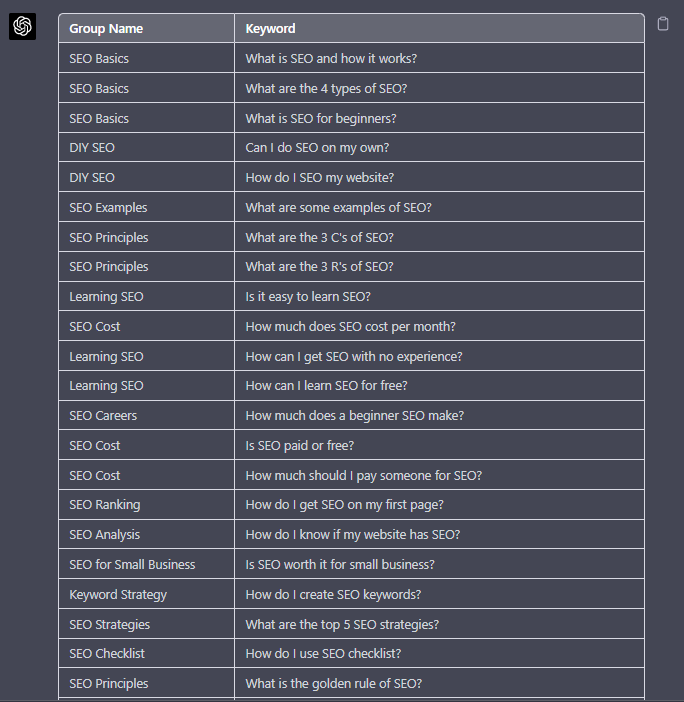 Screenshot from ChatGPT, April 2024
Screenshot from ChatGPT, April 2024
Using Chat GPT For Keyword Expansion By Patterns
One of my favorite methods of doing keyword research is pattern spotting.
Most seed keywords have a variable that can expand your target keywords.
Here are a few examples of patterns:
1. Question Patterns
(who, what, where, why, how, are, can, do, does, will)
“Generate [X] keywords for the topic “[Topic]” that contain any or all of the following “who, what, where, why, how, are, can, do, does, will”
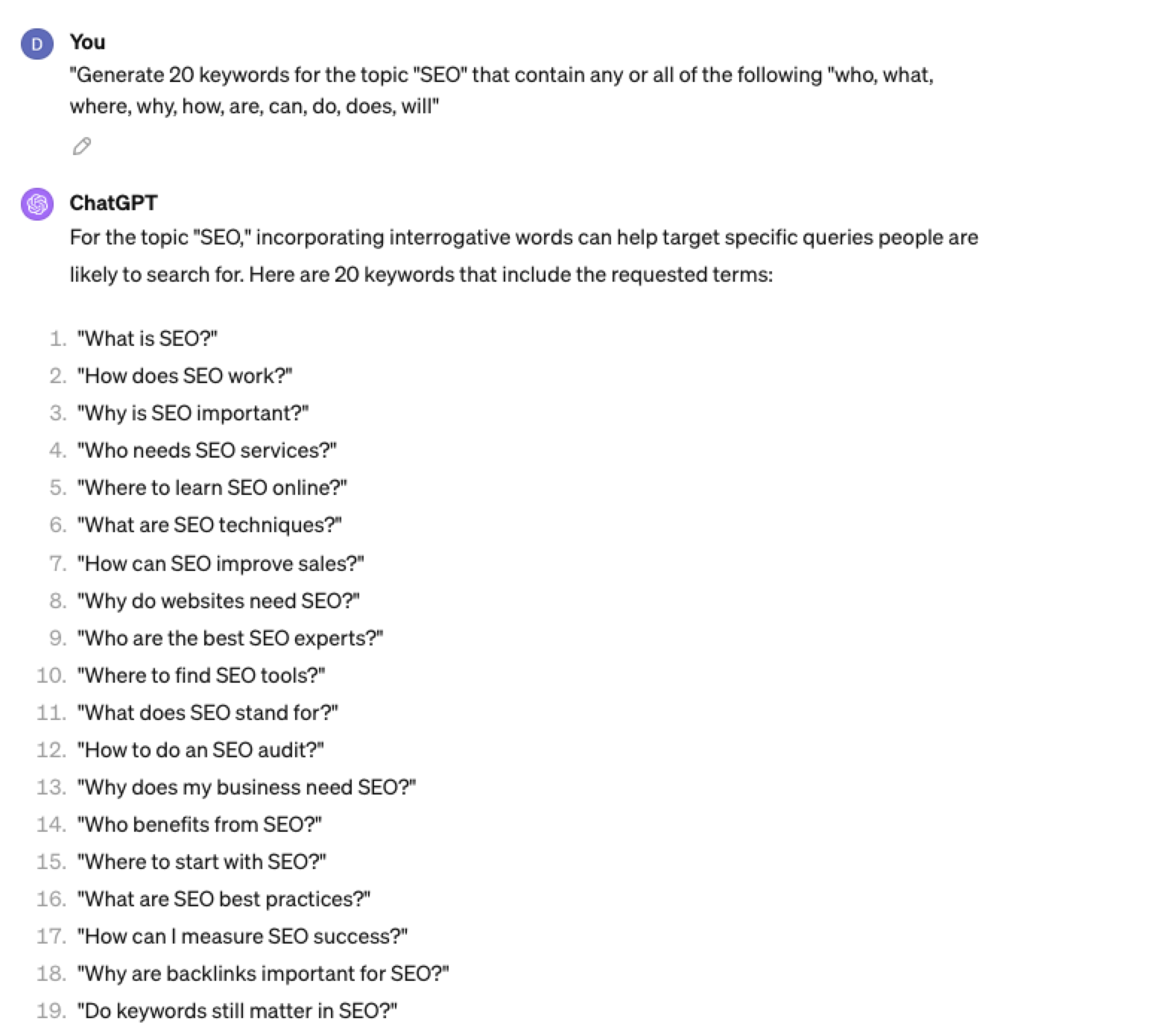 Screenshot ChatGPT 4, April 2024
Screenshot ChatGPT 4, April 20242. Comparison Patterns
Example:
“Generate 50 keywords for the topic “{Topic}” that contain any or all of the following “for, vs, alternative, best, top, review”
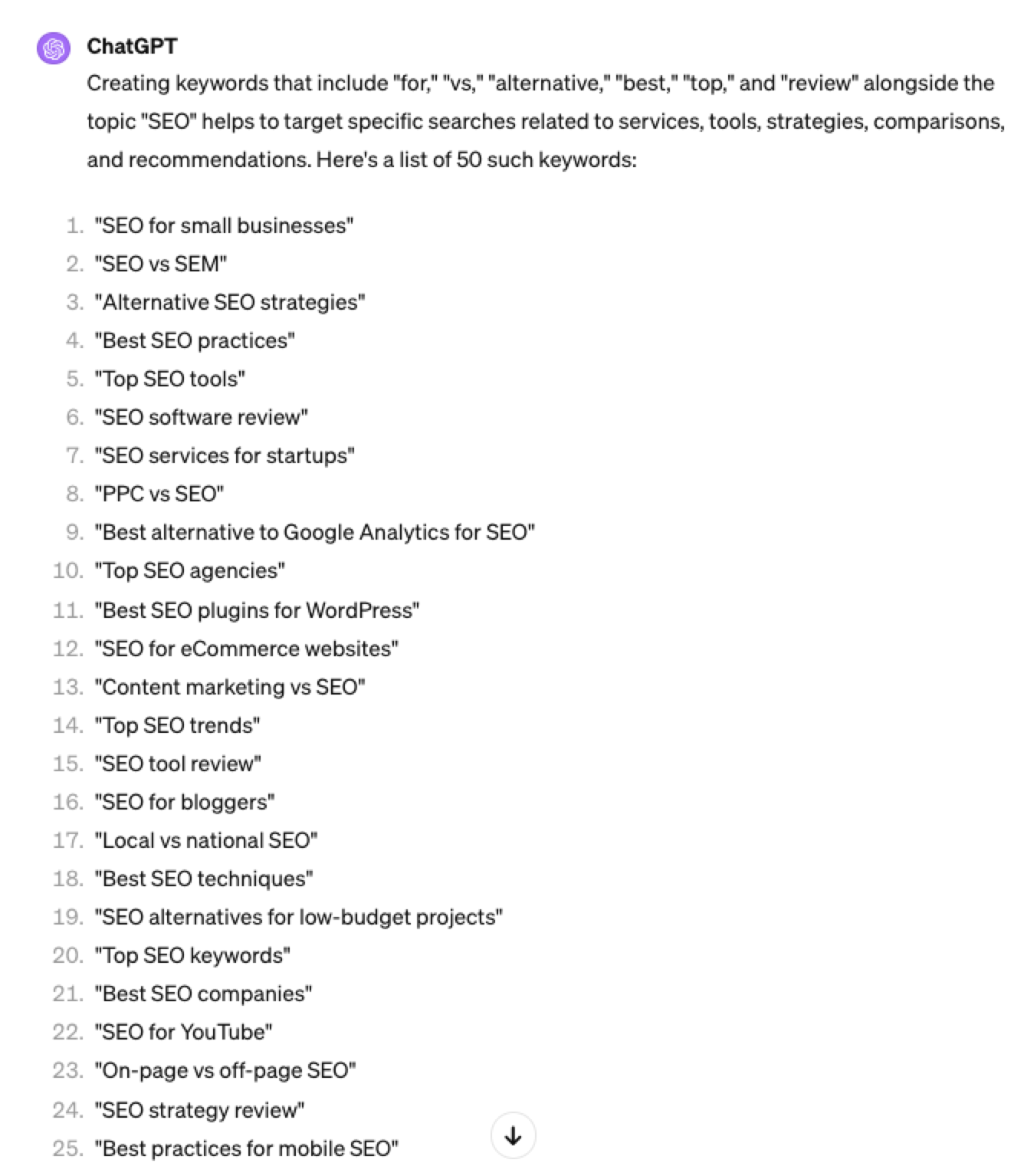 Screenshot ChatGPT 4, April 2024
Screenshot ChatGPT 4, April 20243. Brand Patterns
Another one of my favorite modifiers is a keyword by brand.
We are probably all familiar with the most popular SEO brands; however, if you aren’t, you could ask your AI friend to do the heavy lifting.
Example prompt:
“For the top {Topic} brands what are the top “vs” keywords”
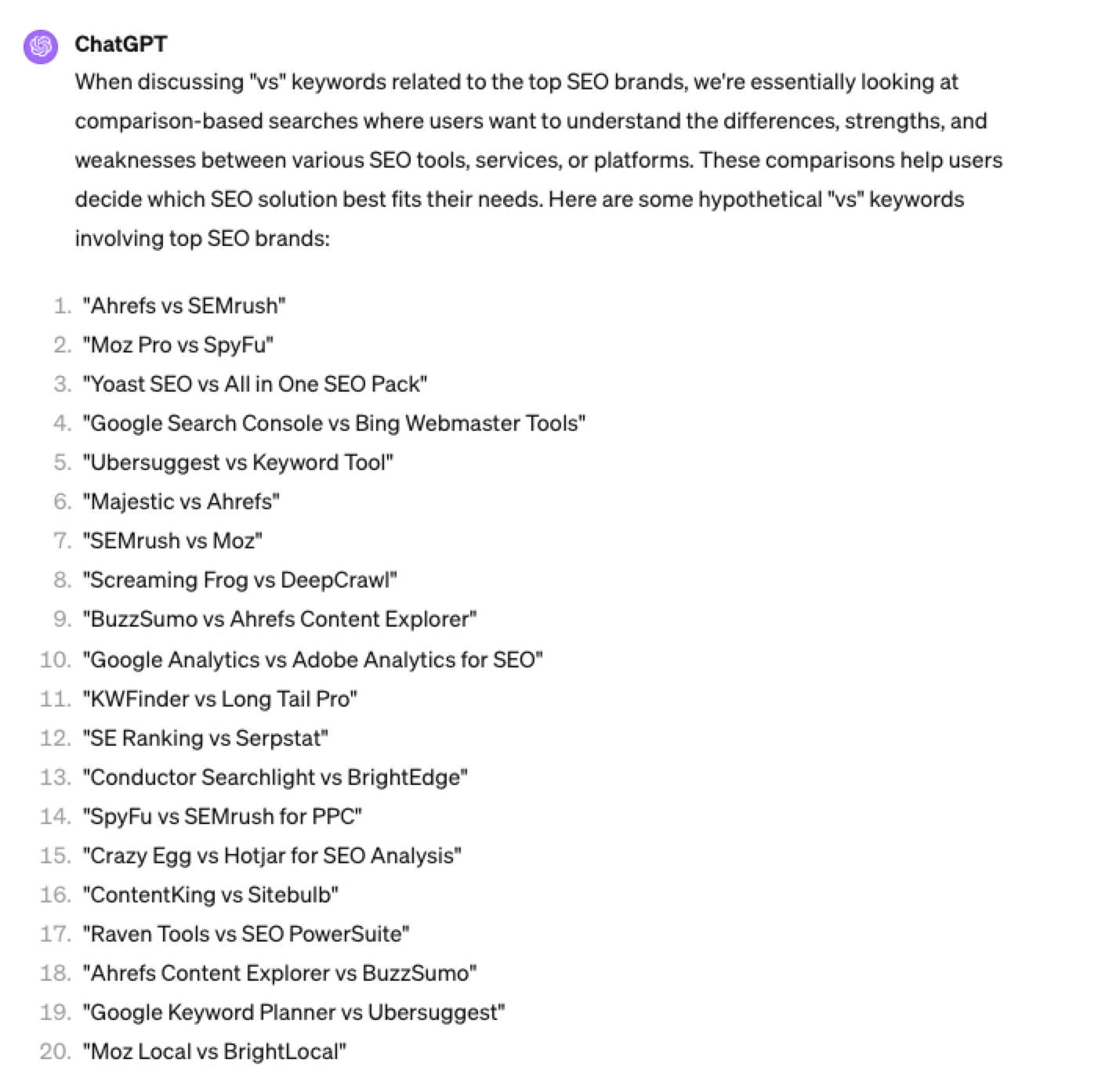 Screenshot ChatGPT 4, April 2024
Screenshot ChatGPT 4, April 20244. Search Intent Patterns
One of the most common search intent patterns is “best.”
When someone is searching for a “best {topic}” keyword, they are generally searching for a comprehensive list or guide that highlights the top options, products, or services within that specific topic, along with their features, benefits, and potential drawbacks, to make an informed decision.
Example:
“For the topic of “[Topic]” what are the 20 top keywords that include “best”
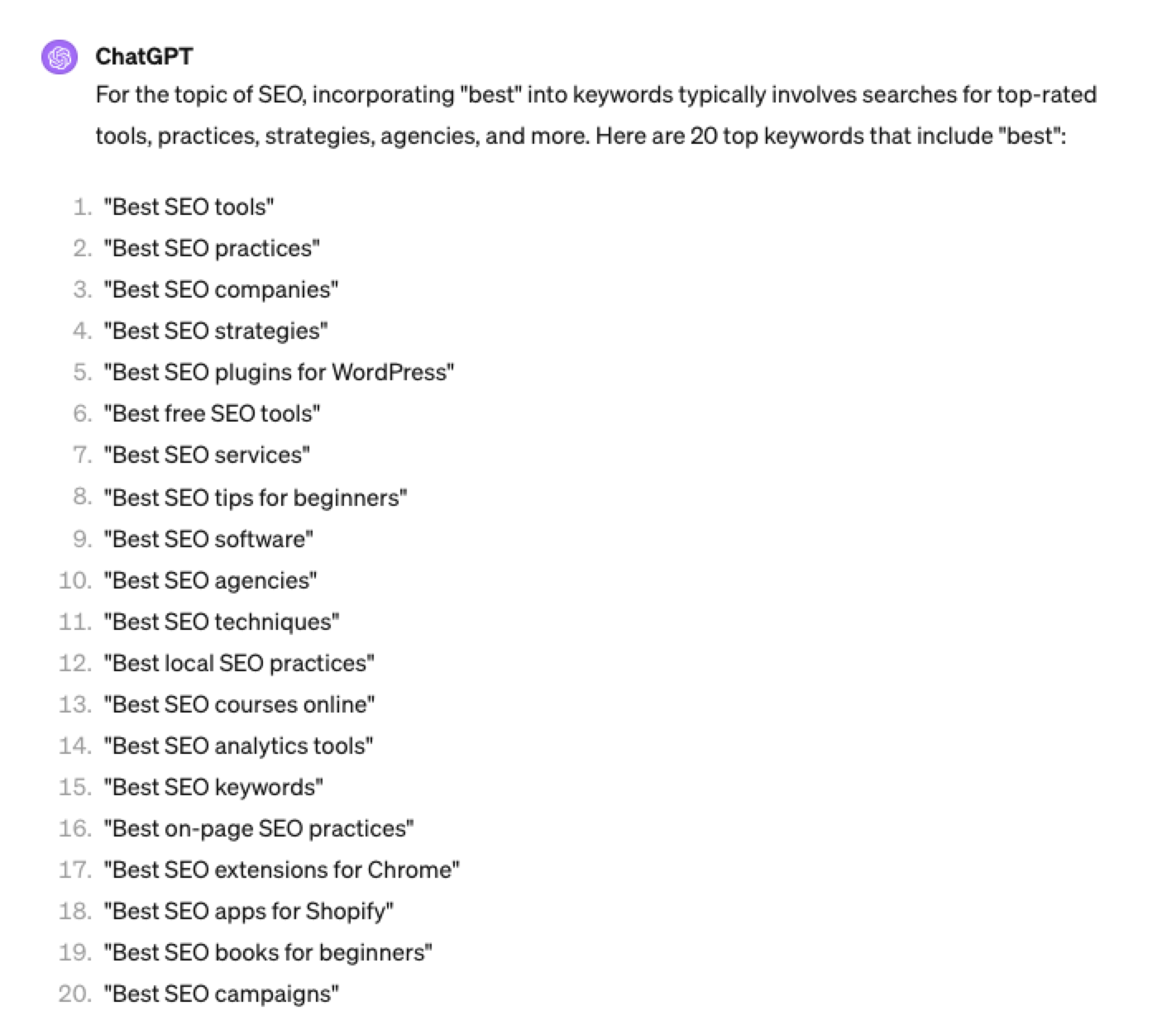 Screenshot ChatGPT 4, April 2024
Screenshot ChatGPT 4, April 2024Again, this guide to keyword research using ChatGPT has emphasized the ease of generating keyword research ideas by utilizing ChatGPT throughout the process.
Keyword Research Using ChatGPT Vs. Keyword Research Tools
Free Vs. Paid Keyword Research Tools
Like keyword research tools, ChatGPT has free and paid options.
However, one of the most significant drawbacks of using ChatGPT for keyword research alone is the absence of SEO metrics to help you make smarter decisions.
To improve accuracy, you could take the results it gives you and verify them with your classic keyword research tool – or vice versa, as shown above, uploading accurate data into the tool and then prompting.
However, you must consider how long it takes to type and fine-tune your prompt to get your desired data versus using the filters within popular keyword research tools.
For example, if we use a popular keyword research tool using filters, you could have all of the “best” queries with all of their SEO metrics:
-
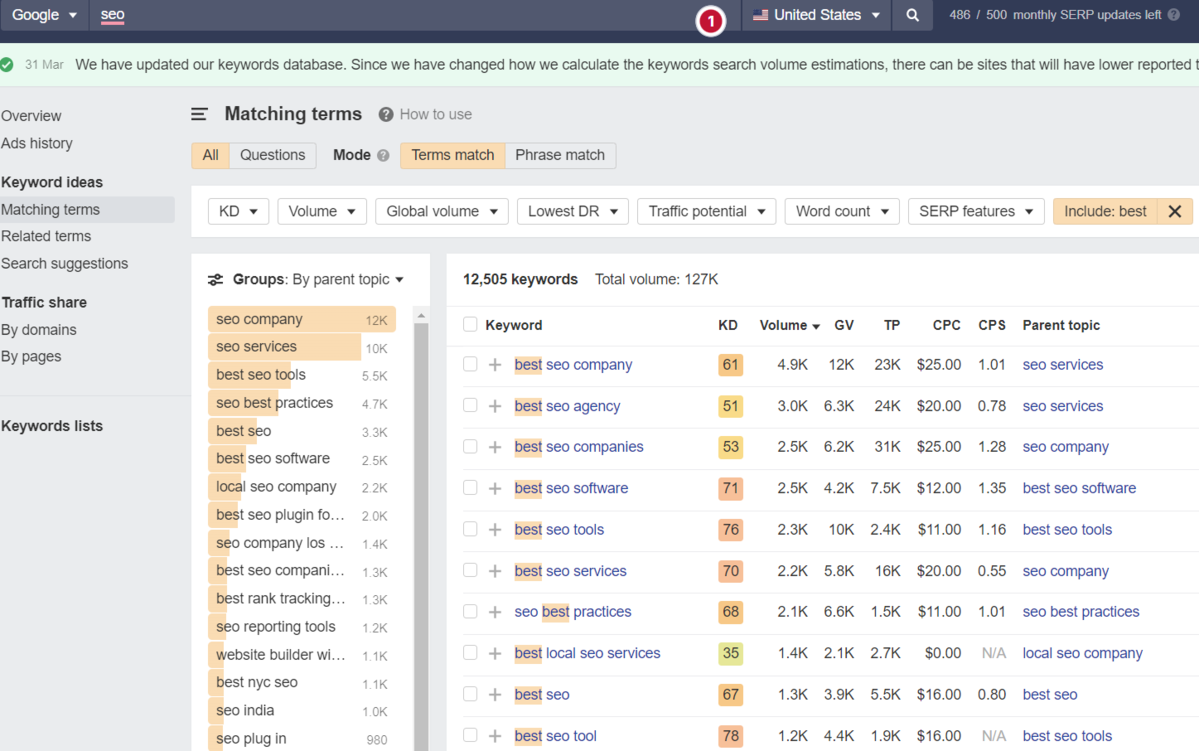 Screenshot from Ahrefs Keyword Explorer, March 2024
Screenshot from Ahrefs Keyword Explorer, March 2024
And unlike ChatGPT, generally, there is no token limit; you can extract several hundred, if not thousands, of keywords at a time.
As I have mentioned multiple times throughout this piece, you cannot blindly trust the data or SEO metrics it may attempt to provide you with.
The key is to validate the keyword research with a keyword research tool.
ChatGPT For International SEO Keyword Research
ChatGPT can be a terrific multilingual keyword research assistant.
For example, if you wanted to research keywords in a foreign language such as French. You could ask ChatGPT to translate your English keywords;
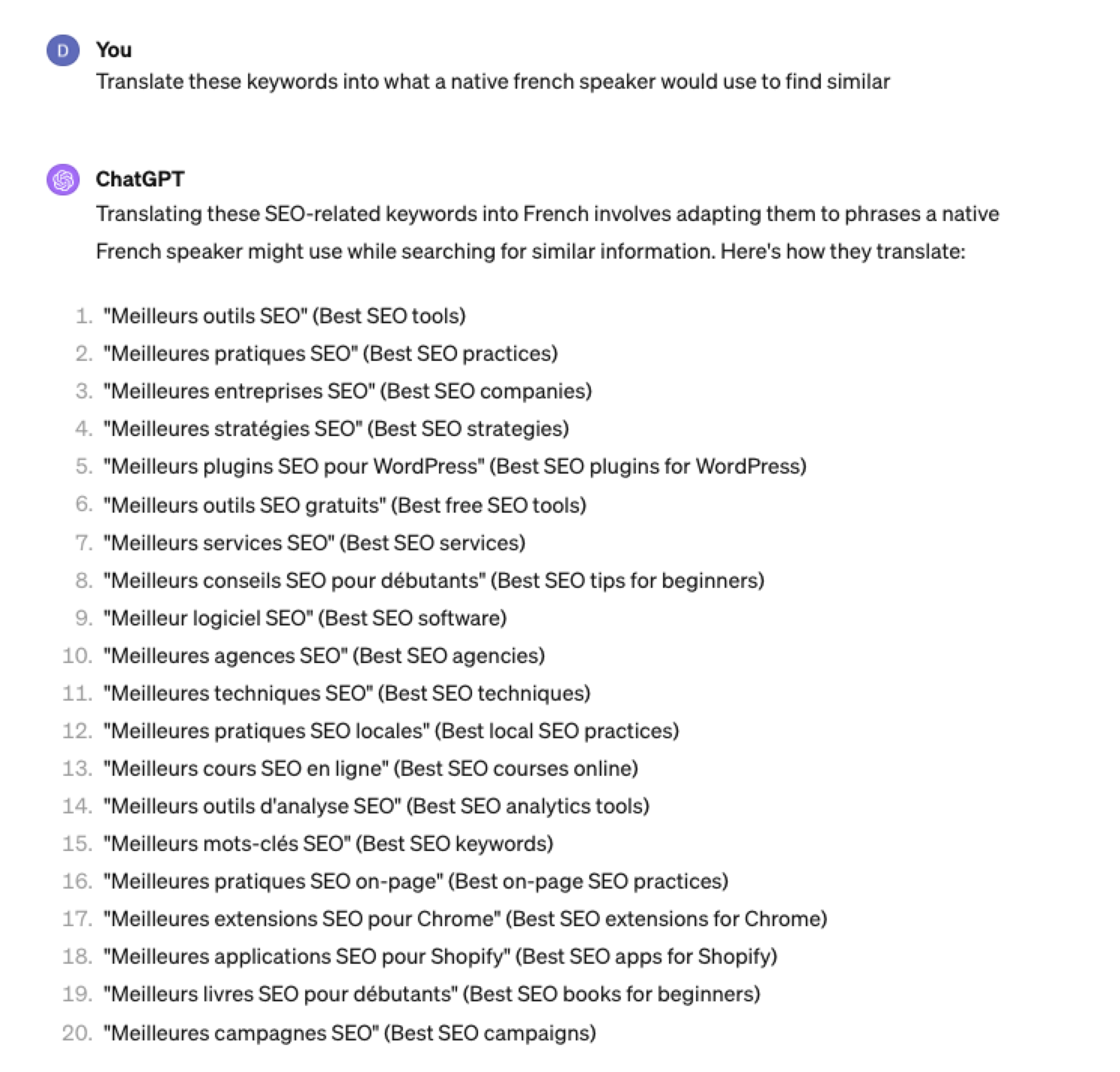 Screenshot ChatGPT 4, Apil 2024
Screenshot ChatGPT 4, Apil 2024- The key is to take the data above and paste it into a popular keyword research tool to verify.
- As you can see below, many of the keyword translations for the English keywords do not have any search volume for direct translations in French.
 Screenshot from Ahrefs Keyword Explorer, April 2024
Screenshot from Ahrefs Keyword Explorer, April 2024But don’t worry, there is a workaround: If you have access to a competitor keyword research tool, you can see what webpage is ranking for that query – and then identify the top keyword for that page based on the ChatGPT translated keywords that do have search volume.
-
-
 Screenshot from Ahrefs Keyword Explorer, April 2024
Screenshot from Ahrefs Keyword Explorer, April 2024
Or, if you don’t have access to a paid keyword research tool, you could always take the top-performing result, extract the page copy, and then ask ChatGPT what the primary keyword for the page is.
Key Takeaway
-
ChatGPT can be an expert on any topic and an invaluable keyword research tool. However, it is another tool to add to your toolbox when doing keyword research; it does not replace traditional keyword research tools.
As shown throughout this tutorial, from making up keywords at the beginning to inaccuracies around data and translations, ChatGPT can make mistakes when used for keyword research.
You cannot blindly trust the data you get back from ChatGPT.
However, it can offer a shortcut to understanding any topic for which you need to do keyword research and, as a result, save you countless hours.
But the key is how you prompt.
The prompts I shared with you above will help you understand a topic in minutes instead of hours and allow you to better seed keywords using keyword research tools.
It can even replace mundane keyword clustering tasks that you used to do with formulas in spreadsheets or generate ideas based on keywords you give it.
Paired with traditional keyword research tools, ChatGPT for keyword research can be a powerful tool in your arsenal.
More resources:
Featured Image: Tatiana Shepeleva/Shutterstock
-

 PPC6 days ago
PPC6 days agoHow the TikTok Algorithm Works in 2024 (+9 Ways to Go Viral)
-

 SEO7 days ago
SEO7 days agoBlog Post Checklist: Check All Prior to Hitting “Publish”
-

 SEO5 days ago
SEO5 days agoHow to Use Keywords for SEO: The Complete Beginner’s Guide
-

 MARKETING6 days ago
MARKETING6 days agoHow To Protect Your People and Brand
-

 SEARCHENGINES7 days ago
SEARCHENGINES7 days agoGoogle Started Enforcing The Site Reputation Abuse Policy
-

 PPC7 days ago
PPC7 days agoHow to Craft Compelling Google Ads for eCommerce
-

 MARKETING7 days ago
MARKETING7 days agoElevating Women in SEO for a More Inclusive Industry
-

 PPC7 days ago
PPC7 days agoHow to Brainstorm Business Ideas: 9 Fool-Proof Approaches






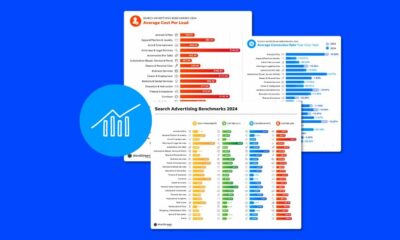

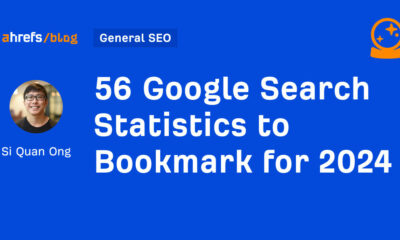







You must be logged in to post a comment Login